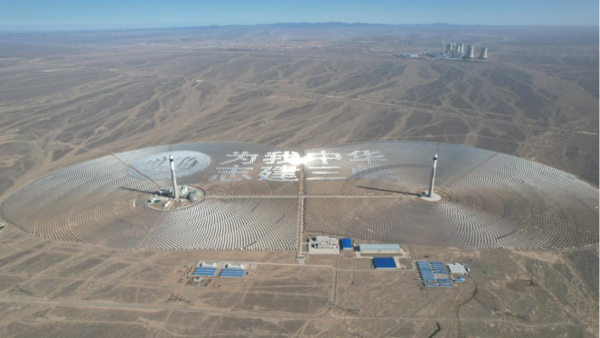The 700-megawatt “Solar Thermal Energy Storage+” project in Guazhou County, Gansu Province, developed by Three Gorges SunSum (Jiuquan) New Energy Power Generation Co., Ltd., a joint venture between China Three Gorges Corporation and SunSum Technology Co., Ltd., has begun full-system trial operations.
This project features the world’s first concentrated solar power (CSP) station with a dual-tower, single turbine design. The simultaneous ignition of its two 200-meter-high receiver towers, confirms its readiness for safe and stable operation.

The 700-megawatt “Solar Thermal Energy Storage+” project was built in Guazhou County, Jiuquan City, Gansu Province. [Photo/sasac.gov.cn]
The two receiver towers are approximately one kilometer apart. Nearly 27,000 heliostats form two partly overlapping circular fields in the east and west, with a total collection area of 800,000 square meters. The mirrors of the heliostats are made of special ultra-clear glass, with 94 percent reflective efficiency, and they can track the movement of the sun. Heliostats in the overlapping area reflect light to the east tower in the morning and to the west tower in the afternoon, maximizing the utilization of solar energy.
This model can flexibly reflect sunlight by precisely adapting to different solar altitude angles at various times, increasing efficiency by approximately 24 percent under the same conditions.
During the energy storage process, the towers store the thermal energy generated by solar power in 565°C liquid molten salt, achieving stable heat storage. When the power station receives the instructions from the power grid, it channels the molten salt to the heat exchange system to boil water and generate steam, which drives the steam turbine to generate electricity. The molten salt heat storage system of this CSP station can store enough thermal energy for a 100 MW unit to operate at full load for six hours. It offers the advantages of long storage time, fast response speed, and stable output power.
The CSP station has dual functions: peak regulation and energy storage. It can complement wind power and photovoltaic power by releasing thermal energy to generate electricity when the output from wind power and photovoltaic power is low, thereby filling the power supply gap. This enables large-scale wind and photovoltaic bases to deliver electricity more effectively to both local and long-distance consumers.
The project comprises a 400 MW wind power station, a 200 MW photovoltaic power station (PV station) and a 100 MW CSP station. The wind power and PV stations have achieved full-capacity grid connection. Once the CSP station becomes operational, the project is expected to provide 1.8 billion kilowatt-hours of electricity, reducing carbon dioxide emissions by about 1.53 million tons.
(Executive editor: Yuan Ting)